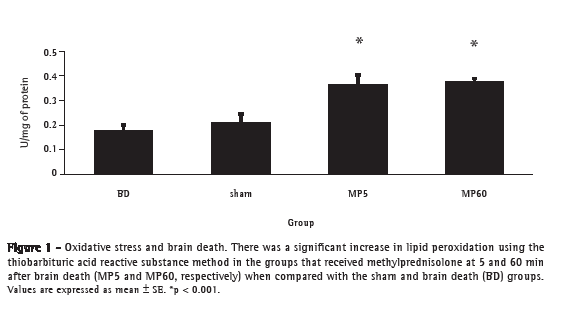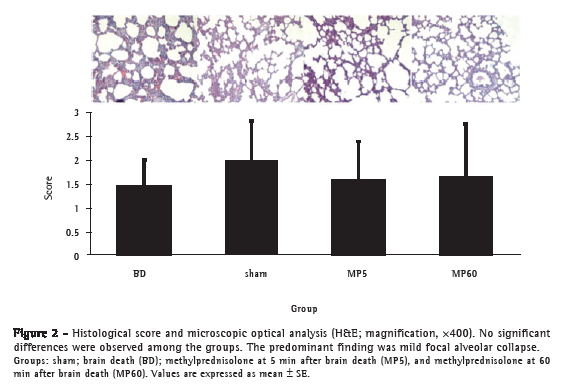



Eduardo Sperb Pilla, Raôni Bins Pereira, Luiz Alberto Forgiarini Junior, Luiz Felipe Forgiarini,Artur de Oliveira Paludo, Jane Maria Ulbrich Kulczynski, Paulo Francisco Guerreiro Cardoso,Cristiano Feijó Andrade
ABSTRACT
Objective: To evaluate the effects that early and late systemic administration of methylprednisolone have on lungs in a rat model of brain death. Methods: Twenty-four male Wistar rats were anesthetized and randomly divided into four groups (n = 6 per group): sham-operated (sham); brain death only (BD); brain death plus methylprednisolone (30 mg/kg i.v.) after 5 min (MP5); and brain death plus methylprednisolone (30 mg/kg i.v.) after 60 min (MP60). In the BD, MP5, and MP60 group rats, we induced brain death by inflating a balloon catheter in the extradural space. All of the animals were observed and ventilated for 120 min. We determined hemodynamic and arterial blood gas variables; wet/dry weight ratio; histological score; levels of thiobarbituric acid reactive substances (TBARS); superoxide dismutase (SOD) activity; and catalase activity. In BAL fluid, we determined differential white cell counts, total protein, and lactate dehydrogenase levels. Myeloperoxidase activity, lipid peroxidation, and TNF-α levels were assessed in lung tissue. Results: No significant differences were found among the groups in terms of hemodynamics, arterial blood gases, wet/dry weight ratio, BAL fluid analysis, or histological score-nor in terms of SOD, myeloperoxidase, and catalase activity. The levels of TBARS were significantly higher in the MP5 and MP60 groups than in the sham and BD groups (p < 0.001). The levels of TNF-α were significantly lower in the MP5 and MP60 groups than in the BD group (p < 0.001). Conclusions:áIn this model of brain death, the early and late administration of methylprednisolone had similar effects on inflammatory activity and lipid peroxidation in lung tissue.
RESUMO
Objetivo: Avaliar os efeitos da administração sistêmica precoce e tardia de metilprednisolona nos pulmões em um modelo de morte encefálica em ratos. Métodos: Vinte e quatro ratos Wistar machos foram anestesiados e randomizados em quatro grupos (n = 6 por grupo): sham, somente morte encefálica (ME), metilprednisolona i.v. (30 mg/kg) administrada 5 min após a morte encefálica (MP5) e 60 min após a morte encefálica (MP60). Os grupos ME, MP5 e MP60 foram submetidos à morte encefálica por insuflação de um balão no espaço extradural. Todos os animais foram observados e ventilados durante 120 min. Foram determinadas variáveis hemodinâmicas e gasométricas, relação peso úmido/seco, escore histológico, thiobarbituric acid reactive substances (TBARS, substâncias reativas ao ácido tiobarbitúrico), atividade de superóxido dismutase (SOD) e de catalase, assim como contagem diferencial de células brancas, proteína total e nível de desidrogenase lática no LBA. A atividade da mieloperoxidase, peroxidação lipídica e níveis de TNF- foram avaliados no tecido pulmonar. Resultados: Não foram observadas diferenças significativas nas variáveis hemodinâmicas e gasométricas, relação peso úmido/seco, análises do LBA, escore histológico, SOD, mieloperoxidase e catalase entre os grupos. Os níveis de TBARS foram significativamente maiores nos grupos MP5 e MP60 do que nos grupos sham e ME (p < 0,001). Os níveis de TNF- foram significativamente menores nos grupos MP5 e MP60 do que no grupo ME (p < 0,001). Conclusões: Neste modelo de morte cerebral, a administração precoce e tardia de metilprednisolona apresentou efeitos semelhantes sobre a inflamação e a peroxidação lipídica no tecido pulmonar.
Palavras-chave: Ratos; Morte encefálica; Estresse oxidativo; Pulmão; Hidroxicorticosteroides.
Introduction

